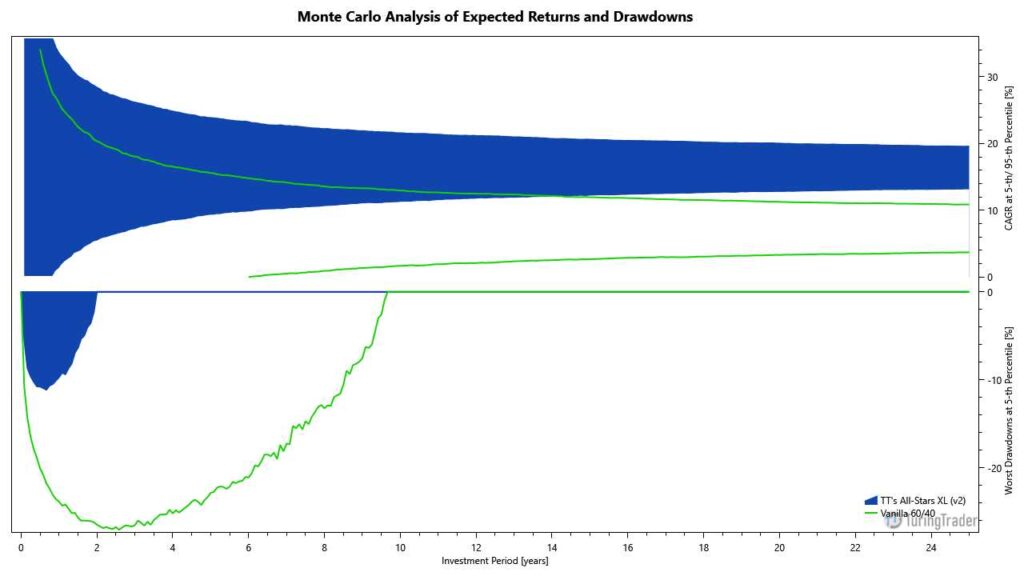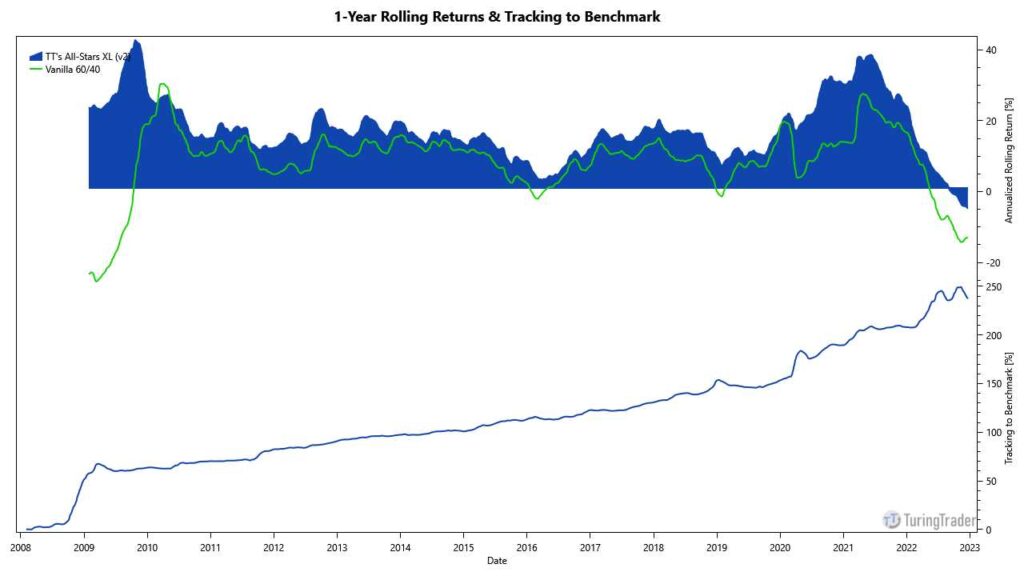Summary
- Objective: aggressive growth
- Type: mean-variance optimization
- Invests in: ETFs tracking stocks, bonds, gold
- Rebalancing schedule: weekly w/ possible daily exit
- Taxation: 90% short-term capital gains
- Minimum account size: $5,000
TuringTrader’s Mach-1 beats the S&P 500 by matching its performance in bullish years but losing less in drawdowns. The proprietary strategy switches between separate models for bull-market and bear-market regimes. Both models use mean-variance optimization to select their assets and assign weights. Mach-1 rebalances weekly and holds no more than three ETFs, resulting in low maintenance effort. However, when markets transition from a bull to a bear-market regime, the strategy may require exiting positions any day. In summary, Mach-1 is an excellent complement to momentum-based strategies and a great choice for investors seeking aggressive growth with low effort.
Performance
This table shows the portfolio’s key performance metrics over the course of the simulation:
The following chart shows the portfolio’s historical performance and drawdowns, compared to their benchmark, throughout the simulation:
This chart shows the portfolio’s annual returns:
The following charts show the Monte-Carlo simulation of returns and drawdowns, the portfolios 12-months rolling returns, and how the portfolio is tracking to its benchmark:


Asset Allocation
The portfolio last required rebalancing after the exchanges closed on @last-rebal@. Due to fluctuations in asset prices, the exact allocations vary daily, even when no rebalancing occurred. The current asset allocation is as follows:
Sign up for our FREE Basic membership to see the asset allocation.
Sign up for our FREE 14-day trial to see the asset allocation.
Strategy Rules
The operation of Mach-1 can be summarized as follows:
- in bull-markets, trade ETFs tracking the S&P 500, Nasdaq-100, Dow-Jones Industrial Average, Russell 2000, S&P MidCap 400, and S&P SmallCap 600 indices
- in bear-markets, trade ETFs tracking U.S. Treasuries with 7-10 year and 20+ year maturity, and gold
- switch between bull- and bear-market regimes based on TuringTrader’s Market Vane indicator
- evaluate the performance of various asset weightings over a lookback period of approximately three months
- rebalance every week, picking the combination with the best modified Sharpe Ratio
Mach-1 is a close cousin of our Mach-2 portfolio but without leverage. The strategy’s mechanism is closely related to LogicalInvest’s Universal Investment Strategy. We enhanced the strategy by adding more assets and switching between separate bull- and bear-market strategies.
Diversification
Mach-1 fully invests in one or more broad indices tracking the U.S. stock market in bullish markets. During bear markets, the portfolio switches to the safety of U.S. treasuries and gold. With these properties, Mach-1 is well diversified in terms of company risk but relies on serial diversification to avoid steep losses.
Our simulation shows a beta of approximately 0.35, indicating successful tactical asset rotation. Nonetheless, investments in Mach-1 have a tail-risk equivalent to the S&P 500.
Returns & Volatility
Mach-1 beats the S&P 500 benchmark in most years with only brief periods of underperformance. The mean-variance optimization helps to manage portfolio volatility, while the market-regime filter helps to avoid deep drawdowns.
Thanks to this active management, Mach-1‘s portfolio volatility is 28% lower than that of the S&P 500. Further, the portfolio’s downside is about 56% lower than buying and holding the benchmark. As a result, Mach-1 beats the stock market’s returns while successfully limiting drawdowns to levels acceptable to conservative investors.
Account & Tax Considerations
Mach-1 is an aggressive strategy. Therefore, we believe that Mach-1 is best used in the context of meta-portfolios, namely All-Stars Weekly.
Mach-1 trades frequently and regularly triggers taxable events. The portfolio rarely holds assets long enough to qualify for long-term treatment of capital gains. However, Mach-1 may still add value to taxable accounts because of the portfolio’s upside over buy-and-hold.
Mach-1 invests in no more than three ETFs at a time. The strategy should function as intended with as little as $5,000 of capital.
